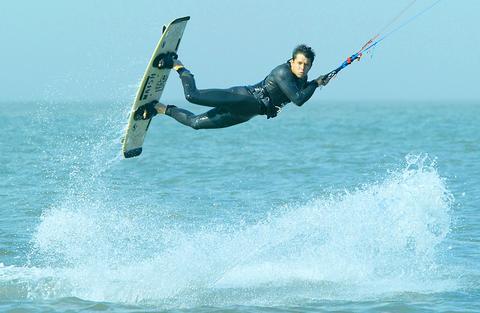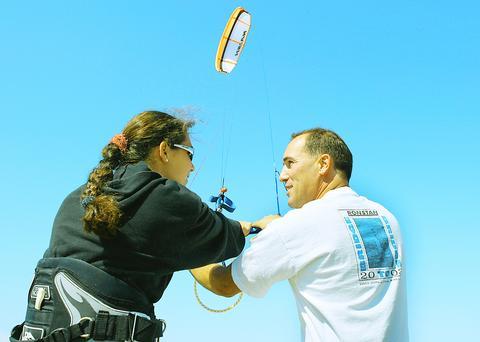Enthusiasts say the extreme sport of kitesurfing, in which a massive wind-powered kite propels a surfer on a small board to defy gravity, can prove more exciting than sex.
But as some have discovered, harnessing the mighty power of the wind as a kitesurfer or kiteboarder is a risky and sometimes fatal adventure.

PHOTOS: REUTERS
Douglas Jenman experienced the dark side of the sport when a gust of wind crashed him into a wall next to a house in Cape Town, South Africa, last year. He broke bones in his feet and legs and compressed his spinal column.

PHOTOS: REUTERS
"I am pretty happy to be alive, as the area I landed [in] is pretty bricked up and the walls had these 10cm metal nails which I missed by inches," he said in an e-mail. "Pretty scary experience and I can still remember the thud, crunch and being winded by the landing."
The sport that mixes elements of kite flying, wind surfing and surfing has grown rapidly over the past five years. Even presidential candidate John Kerry likes kiteboarding, to the consternation of his wife, Teresa Heinz Kerry.

When the winds blow, San Francisco-area kiteboarders rush to the Pacific Ocean to enjoy the power of the waves and the wind. Some are able to leap as high as 6m to 9m into the air, sometimes flying for many seconds.
There is an undeniable rush of excitement as the wind powers the rider and sometimes sweeps the boarder skyward.
"I think if you asked most kiteboarders what they would prefer, a night with their dream woman, or a perfect session in their favorite conditions with their best friends, 99 percent would go for the second option," said Laurel Eastman, 26, who runs a kitesurfing school in the Dominican Republic.
"Kiteboarding has brought incredible joy and fun into my life. The moments when I am out on the sea, sailing with the wind, flying like a bird, are fantastic," she said.
For a sport that relies on nature's power and not technology, kitesurfing is remarkably new, dating back to two French brothers who patented a kite sail design in 1984. The sport really took off when kites in which parts of the frame would inflate to make them easier to fly became widespread.
"Windsurfing peaked back in the '80s with about a million participants. Right now there are only about 100,000 kiteboarders," said Shannon Best, 30, a kiteboarder who started BestKiteBoarding.com to market kitesurfing equipment directly. "We are predicting some huge numbers to definitely start getting into kiteboarding."
With kiteboarding equipment typically costing US$1,500 or more, experts say the industry already chalks up US$80 million to US$100 million in annual sales. Some estimate that there are as many as 250,000 kiteboarders worldwide.
Other sports, such as surfing Hawaii's big waves or motorcycle jumping, may deter some thrill seekers because they look more daunting.
Kiteboarding can be dangerous: the wind strikes suddenly, sending the rider hurtling uncontrollably through the air. Since kiteboarders are strapped to the line by a harness, it feels like being fired from a cannon. Sometimes there may not even be time to reach for the emergency release.
Two or four lines connect the rider to a broad "C" shaped kite ranging from about 6m to 20m long. Pushing and pulling a bar connected to the lines controls the direction and power of the kite.
Kitesurfing is growing in Hawaii, California, Florida, Australia and also appearing in diverse areas such as Venezuela, Croatia, Maldives, Kenya and South Africa
Rick Iossi, a Florida kiteboarder who narrowly survived an accident three years ago, has compiled a list of dramatic kitesurfing injuries, and said about 20 people have died kiteboarding since 2001. "If you get hit by a sudden gust, all bets are off," he said.
These fatalities include a kitesurfer in northern Germany killed in March by crashing against a rock. Other have hit shore walls, docks and houses. In 2002, top German kitesurfer Silke Gorldt died when she became entangled in another kitesurfer's line and smashed against a shoreline fence.
A lawsuit over kitesurfing safety is forthcoming in Florida after one man went into a coma following an accident, his lawyer said.
Designers have incorporated more safety features into the latest kites, and Internet sites such as Iossi's may help others learn from mistakes.
Yet many experts say the answer to improved safety may lie ultimately in requiring certification, a requirement for sports such as hang gliding and diving.
For all its risks, few leave the sport willingly.
Jenman of South Africa said his serious accident will not deter his return to kitesurfing. "It took me four months before I could even think about using crutches. I can now walk, though [I] have lost the sideways movement in both feet," he said.
"I hope to start kiting again in May, on the one-year anniversary of the accident ... I would be pretty upset if I could not kite in the future; to me it is a magic sport."

In the March 9 edition of the Taipei Times a piece by Ninon Godefroy ran with the headine “The quiet, gentle rhythm of Taiwan.” It started with the line “Taiwan is a small, humble place. There is no Eiffel Tower, no pyramids — no singular attraction that draws the world’s attention.” I laughed out loud at that. This was out of no disrespect for the author or the piece, which made some interesting analogies and good points about how both Din Tai Fung’s and Taiwan Semiconductor Manufacturing Co’s (TSMC, 台積電) meticulous attention to detail and quality are not quite up to

April 21 to April 27 Hsieh Er’s (謝娥) political fortunes were rising fast after she got out of jail and joined the Chinese Nationalist Party (KMT) in December 1945. Not only did she hold key positions in various committees, she was elected the only woman on the Taipei City Council and headed to Nanjing in 1946 as the sole Taiwanese female representative to the National Constituent Assembly. With the support of first lady Soong May-ling (宋美齡), she started the Taipei Women’s Association and Taiwan Provincial Women’s Association, where she

It is one of the more remarkable facts of Taiwan history that it was never occupied or claimed by any of the numerous kingdoms of southern China — Han or otherwise — that lay just across the water from it. None of their brilliant ministers ever discovered that Taiwan was a “core interest” of the state whose annexation was “inevitable.” As Paul Kua notes in an excellent monograph laying out how the Portuguese gave Taiwan the name “Formosa,” the first Europeans to express an interest in occupying Taiwan were the Spanish. Tonio Andrade in his seminal work, How Taiwan Became Chinese,

Mongolian influencer Anudari Daarya looks effortlessly glamorous and carefree in her social media posts — but the classically trained pianist’s road to acceptance as a transgender artist has been anything but easy. She is one of a growing number of Mongolian LGBTQ youth challenging stereotypes and fighting for acceptance through media representation in the socially conservative country. LGBTQ Mongolians often hide their identities from their employers and colleagues for fear of discrimination, with a survey by the non-profit LGBT Centre Mongolia showing that only 20 percent of people felt comfortable coming out at work. Daarya, 25, said she has faced discrimination since she